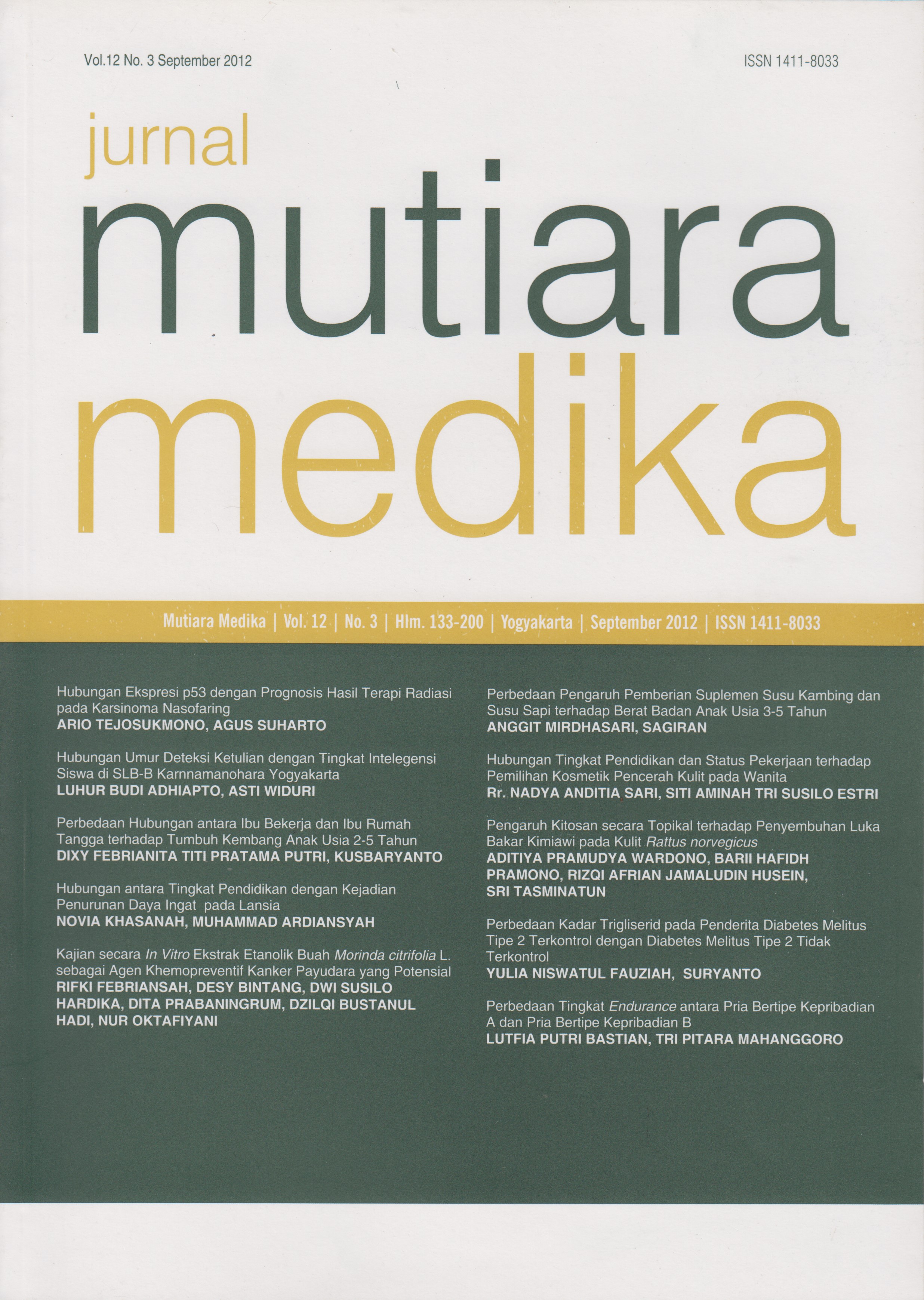Hubungan Umur Deteksi Ketulian dengan Tingkat Intelegensi Siswa di SLB-B Karnnamanohara Yogyakarta
DOI:
https://doi.org/10.18196/mmjkk.v12i3.1031Keywords:
intelegensi, ketulian, umur deteksi ketulian, age of deafness’s detection, deafness, intelligencyAbstract
Deteksi ketulian pada anak khususnya sebelum usia 3 tahun yang kemudian dilakukan intervensi dini akan menghasilkan perkembangan anak yang sangat memuaskan. Akan tetapi, deteksi dini ketulian di Indonesia masih dilaksanakan secara pasif. Hal ini menyebabkan keterlambatan deteksi dan intervensi yang diberikan pada anak, sedangkan dampak ketulian pada anak khususnya ketulian prelingual sangat besar dan dapat berpengaruh pada masa depan anak. Penelitian ini bertujuan untuk mengetahui hubungan deteksi dini ketulian terhadap tingkat intelegensi siswa di SLB-B Karnnamanohara. Jenis penelitian adalah observasional dengan rancangan cross sectional. Subjek penelitian adalah 35 siswa SLB-B Karnnamanohara terbagi dua kelompok yaitu kelompok deteksi dini (<3 tahun) dan terlambat (>3 tahun) dengan total sampling. Pengambilan data menggunakan kuesioner untuk pengelompokkan status umur deteksi ketulian dan tes intelegensi CPM (Coloured Progressive Matrices) untuk menilai tingkat intelegensi siswa yang dikelompokkan menjadi tingkat intelegensi dibawah rata-rata (<25%), rata-rata (75% > x >25%) dan diatas rata-rata (>75%). Data dianalisis menggunakan Crosstab dilanjutkan uji Spearman. Hasil penelitian menunjukkan nilai signifikansi hubungan antara umur deteksi ketulian dengan tingkat intelegensi adalah p=0,321 (p>0,05). Disimpulkan bahwa tidak terdapat hubungan antara umur deteksi ketulian dengan tingkat intelegensi siswa di SLB-B Karnnamanohara Yogyakarta.
Early detection of deafness in hearing loss children especially before 3 years old and then followed by early intervention will produced a satisfactory child’s growth. In other hand, early detection of deafness children in Indonesia still were done passively. This situation can make late detection and late intervention that given to the children, however deafness impact to the children, especially for prelingual deafness is very huge, and can influence with the child’s future. This research is purposed to know the relation between early detection of deafness with degree of intelligence in Karnnamanohara Hearing Impaired School of Yogyakarta. Design of the research is observational and the data taken by croossectional. Research’s subject were all of the Karnnamanohara Hearing Impaired School of Yogyakarta’s student, the amount were 35 students that devided into two groups, early detection group (<3 years old) and late detection group (>3 years old). The data taken by questionaire to classified the status of age of deafness’s detection and CPM (Coloured Progressive Matrice) intelligency test to assess the degree of intelligence that finally divided into under average (<25%), average (75%>x>25%), and above average (>75%). Collected data was analysed with Crosstab continued with Spearmann Test. The result showed the significancy value for the relation between the age of deafness’s detection with the degree of intelligency
References
Jayanto, K.D. Deteksi Pendengaran. 2008. Diakses pada 15 April 2009 dari http://kaskus.us/ showthread.php.
Sastrowiyoto S. Sebab-sebab Ketulian pada Anak. Kumpulan Naskah Konas VII Perhati. Surabaya. 1983.
Atmosoewarno, S. Uji Pendengaran pada Balita. Yogyakarta: IP THT-KL FK-UGM. 2002.
Rianto, B.U. Deteksi Dini pada Anak. Yogyakarta: IP-THT FK-UMY. 2007.
Wechsler, D. The Measurement of Adult Intelligence. (3nd ed.). Baltimore: Williams & Wilkins. 1944.
Purwanto, M.N. Psikologi Pendidikan. Bandung: PT Remaja Rosdakarya. 1992.
Raven, J.C. Guide to using the Coloured Progressive Matrices. Yogyakarta : Salina Fakultas Psikologi UGM. 1974.
Setiajit, B. Identifikasi Faktor-faktor Keterlambatan Memeriksakan Dini Ketulian Prelingual. Tesis. Yogyakarta: Universitas Gadjah Mada. 1994.
Zekveld, AA., Deijen JB, Goverts ST, Kramer SE. The Relationship between Nonverbal Cognitive Functions and Hearing Loss. J Speech Lang Hear Res. 2007; 50 (1): 74-82.
Karyono. Pengaruh Ketulian pada Psikis Anak dan Pengelolaannya. Majalah Cermin Dunia Kedokteran. 1985; (39): 21-23.
Nicholas, J,G., Geers, A,E. Effects of early auditory experience on the spoken language of deaf children at 3 years of age. Ear Hear. 2006; 27 (3): 286-298.
Gregory, S. The Deaf Child and His Family. London: Allen and Unwin Ltd. 1976.
Denmark, J. Early Profound Deafness and Mental Retardation. British Journal of Mental Subnormality, 1978; 24 (2, No 47): 81-89.
Vygotsky, L. S. Thought and language. Cambridge, MA: The MIT Press. 1962. Published originally in Russian in 1934.
Irawan. Hubungan Gender dan Tingkat Kecerdasan. 2005. diakses dari http://forum.wgaul. com/archive/thread/t-38758-Gender-DanTingkat-Kecerdasan-Ada-Hubungankah.html pada 21 April 2009
Woll, B., Kyle, J., Deuchar, M. Perspectives on British Sign Language and Deafness. London: Taylor & Francis. 1981.
Downloads
Published
Issue
Section
License
Copyright
Authors retain copyright and grant Mutiara Medika: Jurnal Kedokteran dan Kesehatan (MMJKK) the right of first publication with the work simultaneously licensed under an Attribution 4.0 International (CC BY 4.0) that allows others to remix, adapt and build upon the work with an acknowledgment of the work's authorship and of the initial publication in Mutiara Medika: Jurnal Kedokteran dan Kesehatan (MMJKK).
Authors are permitted to copy and redistribute the journal's published version of the work (e.g., post it to an institutional repository or publish it in a book), with an acknowledgment of its initial publication in Mutiara Medika: Jurnal Kedokteran dan Kesehatan (MMJKK).
License
Articles published in the Mutiara Medika: Jurnal Kedokteran dan Kesehatan (MMJKK) are licensed under an Attribution 4.0 International (CC BY 4.0) license. You are free to:
- Share — copy and redistribute the material in any medium or format.
- Adapt — remix, transform, and build upon the material for any purpose, even commercially.
This license is acceptable for Free Cultural Works. The licensor cannot revoke these freedoms as long as you follow the license terms. Under the following terms:
Attribution — You must give appropriate credit, provide a link to the license, and indicate if changes were made. You may do so in any reasonable manner, but not in any way that suggests the licensor endorses you or your use.
- No additional restrictions — You may not apply legal terms or technological measures that legally restrict others from doing anything the license permits.






